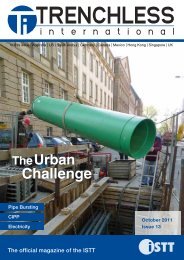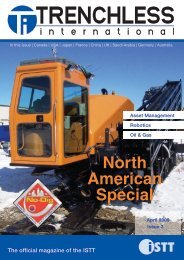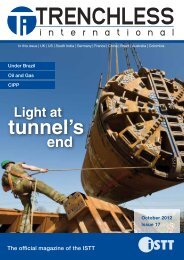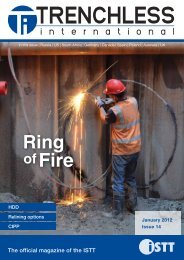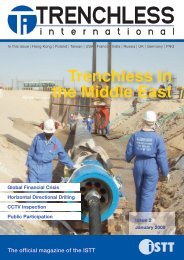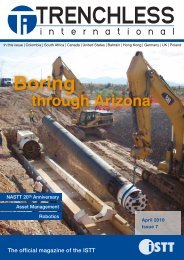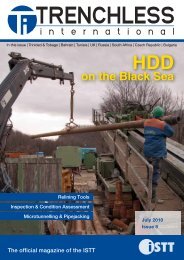Singapore - Trenchless International
Singapore - Trenchless International
Singapore - Trenchless International
Create successful ePaper yourself
Turn your PDF publications into a flip-book with our unique Google optimized e-Paper software.
CIPP<br />
October 2010 - <strong>Trenchless</strong> <strong>International</strong><br />
28<br />
the story behind the pipe:<br />
an inside look at CIPP<br />
By Dec Downey, Chairman ISTT<br />
Cured-in-place-pipe (CIPP) has had an revolutionising effect on the world of<br />
infrastructure and asset management. Here <strong>Trenchless</strong> <strong>International</strong> looks at the<br />
history of the technology, how it was created, patented and its importance in the<br />
trenchless industry.<br />
accOrdING TO INduSTry legend, agricultural engineer Eric<br />
Wood was repairing a corrosion hole in an air duct on a mushroom<br />
farm when he conceived the concept behind CIPP – the use<br />
of fluid pressure to press the repair medium against the pipe wall<br />
whilst it cured in place to form a new pipe.<br />
Whatever the truth of that story, the fact is that Mr Wood, ably<br />
supported by entrepreneurs Doug Chick and Brain Chandler<br />
started an industry with a far-reaching effect on the infrastructure<br />
business, which has endured almost forty years.<br />
Wood, Chick and Chandler took the concept, sourced materials<br />
from resin producer scott Bader and felt maker WE Rawson<br />
and developed what we know as Insituform. they took the idea<br />
to the Greater London Council’s Metropolitan Water Board as a<br />
means to restore ageing water mains and were given the opportunity<br />
to demonstrate the efficacy of their method by lining a<br />
The Brandenburger UV light curing in action.<br />
100-year-old brick egg-shaped sewer at their own expense.<br />
In 1971 they impregnated a felt tube with polyester resin,<br />
wrapped in a plastic sheet, pulled the 70 m tube into the<br />
1,175.675 mm Marsh Lane sewer, inflated it and left it to cure.<br />
tested in 1991, after twenty years in service, it met the 4-34-04<br />
flexural modulus requirements – a research-based group of WRc<br />
– providing consultancy in the water, waste and environment<br />
sectors in the UK – by a margin of more than 20 per cent. this<br />
validated what many municipal engineers worldwide had already<br />
concluded: CIPP is here to stay.<br />
Wood, Chick and Chandler registered the company Insituform<br />
Pipes and structures Ltd (the first of many vehicles for patents<br />
and technology), and set about marketing their technology and<br />
developing improvements such as polymer coated felt and<br />
vacuum impregnation.<br />
they tried steam and UV curing too, but concentrated efforts on<br />
the time-proven water inversion and hot water cure system.<br />
By 1986, with licensed partners in the United Kingdom, they<br />
had completed over 400 projects for regional water authorities,<br />
municipal boroughs, power generators and commercial companies.<br />
As early as 1976 they lined pressure pipes, the first being a<br />
600 mm force main for thames Water in Reading.<br />
In the late 1970s they licensed various companies including<br />
Entrepose in France, Olimb in Norway, Per Aarsleff in Denmark,<br />
Monier in Australia and started a company in North America. With<br />
no shortage of entrepreneurship for Eric, Doug and Brian, they<br />
established Insituform North America Inc and Insituform Group<br />
Ltd in Guernsey as a royalty collector.<br />
these companies were floated on NAsDAQ, an American stock<br />
exchange, and the proceeds invested in R&D and tube making<br />
in Wellingborough and Memphis, tenessee. Both Insituform companies<br />
began to acquire back licensee businesses to vertically<br />
integrate and in 1991 merged to form Insituform technologies Inc.<br />
Strong patent protection<br />
this remarkable growth story was fostered by strong patent<br />
protection and some remarkably good licensed partners. But the<br />
protection afforded by patents is transient and long before the<br />
expiry of the first layers of protection others had noted the extraordinary<br />
growth of the business.<br />
In Japan in 1980, the tokyo and Osaka Gas Companies,<br />
with their contractors, developed hose lining systems using<br />
woven polyester hose and epoxy and polyester resins. By<br />
1983, PALtEM and Phoenix were well established and enhanced<br />
with felt for extra stiffness became used in water mains and sewers.<br />
Phoenix was licensed in France and switzerland and rapidly<br />
spread through Europe. Also in France, in the early 1980s the<br />
Copeflex process, a resin impregnated glass fibre liner developed<br />
by Coopetanche and subsequently acquired by sADE made<br />
inroads into the municipal sewer business.<br />
In Germany, the sewer maintenance group Kanal Muller, once<br />
sales agents for Insituform, developed and licensed a felt liner<br />
system, InLiner, which is installed using a calibration hose, and<br />
in sweden, Volmar Johnsson developed the glass fibre hose, UV<br />
light cured InPipe system.<br />
In the 1980s, with initial patents reaching maturity, many<br />
developers looked at the lucrative licensing route for taking their<br />
processes to market, and the multiple CIPP technologies spread<br />
to the far corners of the globe – Korea, New Zealand, taiwan,<br />
Venezuela and Argentina. Insituform, KMG and Ashimori, developers<br />
of PALtEM, set up in unlicensed territories.<br />
In the late 1980s, Insituform’s felt supplier WE Rawson established<br />
Applied Felts to service the needs of the many users of the<br />
basic felt and resin liner systems and other smaller felt liner makers<br />
were established in Europe and America.<br />
Prompted by the principles proven in the municipal market<br />
and the success of products such as the KMG Houseliner, other<br />
smaller contractors working with simple resin and felt systems<br />
began to work in local markets, servicing the needs of householders<br />
and other private sewer owners.<br />
the size of this market is hard to quantify but some measure<br />
of it is indicated by the UK Government’s decision to take about<br />
half the private sewer, some 200,000 km, into public ownership.<br />
In the UK, franchised sewer maintenance contractors groups<br />
such as DynoRod have seized on the opportunity and provide<br />
distribution for some of the smaller vendors who have focussed<br />
on this market.<br />
In the 1990s more UV light curing systems emerged in Europe<br />
with first Brandenburger, then BKP Berolina, saertex Multiliner<br />
and Impreg entering the fray.<br />
their impact has perhaps been influenced by the technical<br />
demands of the German market and the efforts of IKt, an independent<br />
test laboratory in promoting its facilities and research<br />
initiatives since about 2004. the annual performance tables of<br />
IKt have caught the attention of owners and specifiers and now a<br />
number of European contractors and municipalities are involved<br />
in a pan European testing scheme which annually ranks the performance<br />
of contractors.<br />
confidence in cIPP<br />
technical guidelines and standards play an important role in<br />
the acceptance and growth of technologies, particularly in the<br />
municipal infrastructure business. the role of WRc in developing<br />
its Manual of sewer Condition Classification and its sewer<br />
Rehabilitation Manual in 1983 cannot be understated. these<br />
together with the WRc Information and Guidance Note (Water<br />
Industry standard) 4-34-04 have influence the adoption of sewer<br />
rehabilitation techniques in general, and CIPP in particular,<br />
throughout the English-speaking world and beyond.<br />
the WRc Approval, an independent view on performance<br />
against accepted standards is also useful and many countries<br />
have similar systems. the Japan Institute for Wastewater<br />
Engineering technology is a particularly good example of a<br />
systematic evaluation program in the public interest. Following on<br />
from WIs 4-34-04 in 1985 came AtsM F1216 in 1979, EN 13566-4<br />
in 2002 and now IsO 11296 in 2009; all serve to build confidence<br />
in the CIPP concept but require that the utility owners and their<br />
contractors implement proper systems for product acceptance,<br />
quality control and assurance.<br />
The Right Tool<br />
Manhole<br />
Renewal<br />
Tool Box<br />
Permacast® Liners<br />
Cor+Gard® Coatings<br />
Permaform ®<br />
Con MIC Shield®<br />
Calcium Aluminate Cements<br />
Water Plug & Patch<br />
COR+ROC Structual Polymer<br />
I & I Barrier®<br />
Top Seal TM CIPP Chimney Liners<br />
Spray Equipment<br />
Applicators<br />
Worldwide in<br />
Denmark,<br />
Ireland, UK,<br />
<strong>Singapore</strong>,<br />
Israel,<br />
Norway,<br />
Sweden<br />
and USA.<br />
For Every Problem!<br />
AP/M PERMAFORM<br />
Fax: +515.276.1274 • www.permaform.net<br />
®<br />
CIPP<br />
October 2010 - <strong>Trenchless</strong> <strong>International</strong> 29






